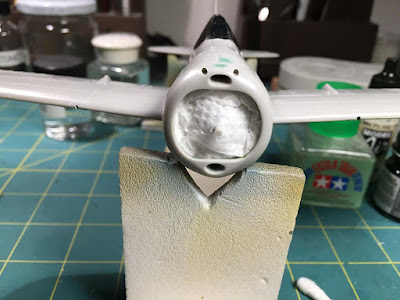F8F-1B Bearcat, Hobby Boss, 1/48 scale, Kit no. 80357
For quite a long time, I have only been modeling World War II aircraft and armor. Making a model of the Bearcat will be a departure.
A few years ago, I read Hell in a Very Small Place: The Siege of Dien Bien Phu by Bernard Fall (Lippincott 1966). I had no idea what the French soldiers and nurses suffered there and the fight they put up against increasingly hopeless odds. Young French nurses and paratroopers were jumping into the caldron right up until the surrender. (A few Americans died flying some of the C-47s carrying them.)
To say that their courage and fighting ability were breathtaking is an understatement. And flying mission after mission at the very edge of their range were the pilots of the Grumman Bearcats delivering rockets and bombs to the North Vietnamese Army that was growing in strength and numbers by the day. The French high command wanted to draw the NVAs into a set piece battle and a base in the valley at Dien Bien Phu was to draw them in. That part of the plan worked very well.
The Bearcat went into squadron service in May 1945, but final preparations and training for combat were still underway when Japan surrendered in August. The Bearcat remained in production until 1949 and equipped a number of squadrons. The basic design requirements were for an aircraft with the biggest possible engine in the smallest possible airframe. It was a pure interceptor/fighter. Which is why when the Korean Conflict came along, the U. S. Navy looked at the Bearcat’s ordnance carrying ability and decided to take the F4U Corsair to Korea in the ground attack role as the Corsair could lift a lot more weight. Therefore, the Bearcat flew not a single combat mission in U. S. service.
The French had received a huge number of American aircraft during and after WWII. Among them were a number of Bearcats which the French used in a ground attack role during their war in Vietnam.
As to the kit, Hobby Boss has not been my favorite maker. I bought one of the their Hellcats (with the FAA markings). The shape on that model was as far off as anything I have ever seen. The fuselage was more like a barrel. It is still in the stash, but its use will come when I need another paint dummy (a position currently being filled with an ancient Monogram Fw190).
As to their Bearcat kit, it has been the recipient of many very complimentary reviews. I have examined it, and cannot see any faults at all. Hobby Boss is reprieved for now.
There will only be three dominant colors. The aircraft is overall dark sea blue, and Testors Acryl #4686 is perfect. It produces a semi-gloss finish ready for decals. The wheel wells are yellow zinc chromate (Acryl #4851) and the interior is interior green (Acryl #4736). The rest will be some hand-brushed details.
We will see if I stay with the kit decals. I was ordering a few items from Hannant’s in the UK, and I added some decals that looked good. Hopefully they will be.
Aside from that, the only after market item will be some Eduard seat belts. (I cannot seem to build a model without something from Eduard finding its way in.)
And, now I will post this and get to work on my tribute to the brave airman and soldiers of France who fought their hopeless battle so long ago and far away. As a veteran of our war in Vietnam (U. S. Army Intelligence Service, MACV, J-2, 1965-1966), I am in awe of what they did.
As to their Bearcat kit, it has been the recipient of many very complimentary reviews. I have examined it, and cannot see any faults at all. Hobby Boss is reprieved for now.
There will only be three dominant colors. The aircraft is overall dark sea blue, and Testors Acryl #4686 is perfect. It produces a semi-gloss finish ready for decals. The wheel wells are yellow zinc chromate (Acryl #4851) and the interior is interior green (Acryl #4736). The rest will be some hand-brushed details.
We will see if I stay with the kit decals. I was ordering a few items from Hannant’s in the UK, and I added some decals that looked good. Hopefully they will be.
Aside from that, the only after market item will be some Eduard seat belts. (I cannot seem to build a model without something from Eduard finding its way in.)
And, now I will post this and get to work on my tribute to the brave airman and soldiers of France who fought their hopeless battle so long ago and far away. As a veteran of our war in Vietnam (U. S. Army Intelligence Service, MACV, J-2, 1965-1966), I am in awe of what they did.










































